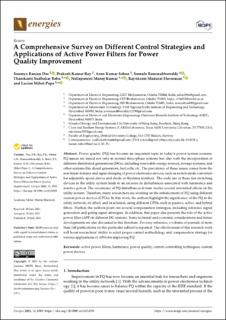| dc.contributor.author | Das, Soumya Ranjan | |
| dc.contributor.author | Ray, Prakash Kumar | |
| dc.contributor.author | Sahoo, Arun Kumar | |
| dc.contributor.author | Ramasubbareddy, Somula | |
| dc.contributor.author | Babu, Thanikanti Sudhakar | |
| dc.contributor.author | Kumar, Nallapaneni Manoj | |
| dc.contributor.author | Elavarasan, Rajvikram Madurai | |
| dc.contributor.author | Mihet-Popa, Lucian | |
| dc.date.accessioned | 2021-09-29T13:37:21Z | |
| dc.date.available | 2021-09-29T13:37:21Z | |
| dc.date.created | 2021-07-28T13:10:50Z | |
| dc.date.issued | 2021 | |
| dc.identifier.citation | Energies. 2021, 14 (15), Artikkel 4589. | en_US |
| dc.identifier.issn | 1996-1073 | |
| dc.identifier.uri | https://hdl.handle.net/11250/2786083 | |
| dc.description | This article is an open access article distributed under the terms and conditions of the Creative Commons Attribution (CC BY) license (https://creativecommons.org/licenses/by/4.0/). | en_US |
| dc.description.abstract | Power quality (PQ) has become an important topic in today’s power system scenario. PQ issues are raised not only in normal three-phase systems but also with the incorporation of different distributed generations (DGs), including renewable energy sources, storage systems, and other systems like diesel generators, fuel cells, etc. The prevalence of these issues comes from the non-linear features and rapid changing of power electronics devices, such as switch-mode converters for adjustable speed drives and diode or thyristor rectifiers. The wide use of these fast switching devices in the utility system leads to an increase in disturbances associated with harmonics and reactive power. The occurrence of PQ disturbances in turn creates several unwanted effects on the utility system. Therefore, many researchers are working on the enhancement of PQ using different custom power devices (CPDs). In this work, the authors highlight the significance of the PQ in the utility network, its effect, and its solution, using different CPDs, such as passive, active, and hybrid filters. Further, the authors point out several compensation strategies, including reference signal generation and gating signal strategies. In addition, this paper also presents the role of the active power filter (APF) in different DG systems. Some technical and economic considerations and future developments are also discussed in this literature. For easy reference, a volume of journals of more than 140 publications on this particular subject is reported. The effectiveness of this research work will boost researchers’ ability to select proper control methodology and compensation strategy for various applications of APFs for improving PQ. | en_US |
| dc.language.iso | eng | en_US |
| dc.publisher | MDPI | en_US |
| dc.rights | Navngivelse 4.0 Internasjonal | * |
| dc.rights.uri | http://creativecommons.org/licenses/by/4.0/deed.no | * |
| dc.subject | active power filters | en_US |
| dc.subject | harmonics | en_US |
| dc.subject | power quality | en_US |
| dc.subject | current controlling techniques | en_US |
| dc.subject | custom power devices | en_US |
| dc.title | A Comprehensive Survey on Different Control Strategies and Applications of Active Power Filters for Power Quality Improvement | en_US |
| dc.type | Peer reviewed | en_US |
| dc.type | Journal article | en_US |
| dc.description.version | publishedVersion | en_US |
| dc.rights.holder | © 2021 by the authors. | en_US |
| dc.subject.nsi | VDP::Teknologi: 500::Elektrotekniske fag: 540 | en_US |
| dc.source.volume | 14 | en_US |
| dc.source.journal | Energies | en_US |
| dc.source.issue | 15 | en_US |
| dc.identifier.doi | 10.3390/en14154589 | |
| dc.identifier.cristin | 1922875 | |
| dc.source.articlenumber | 4589 | en_US |
| cristin.ispublished | true | |
| cristin.fulltext | original | |
| cristin.qualitycode | 1 | |

